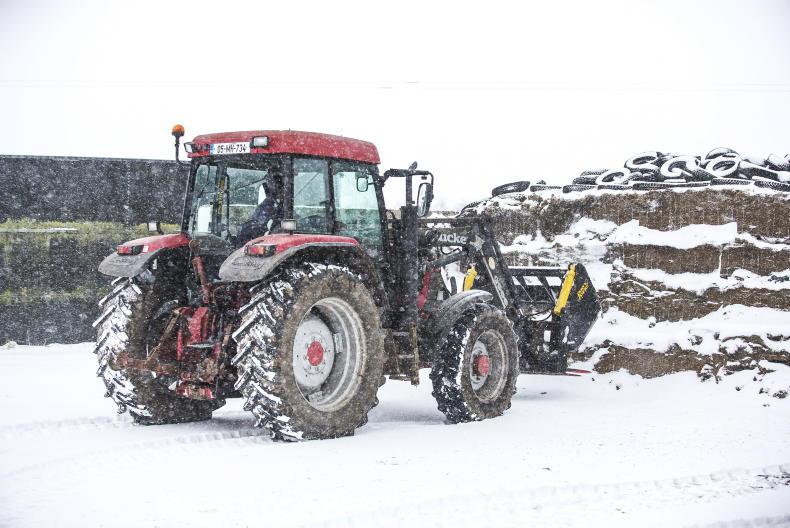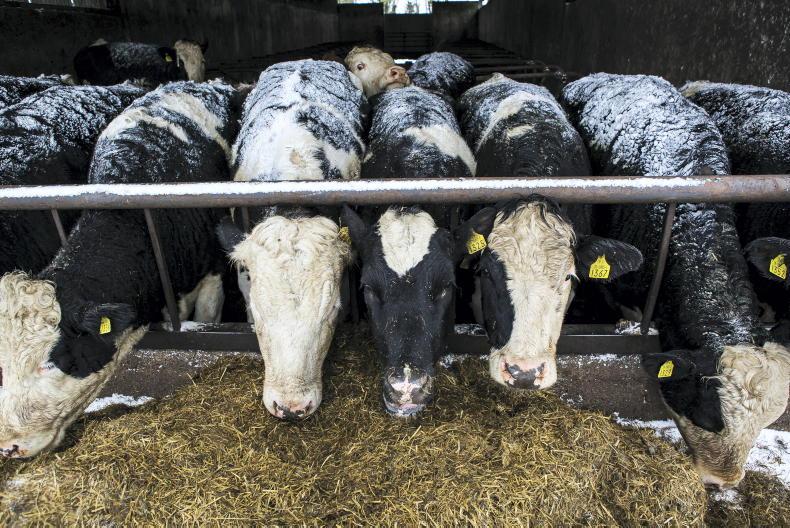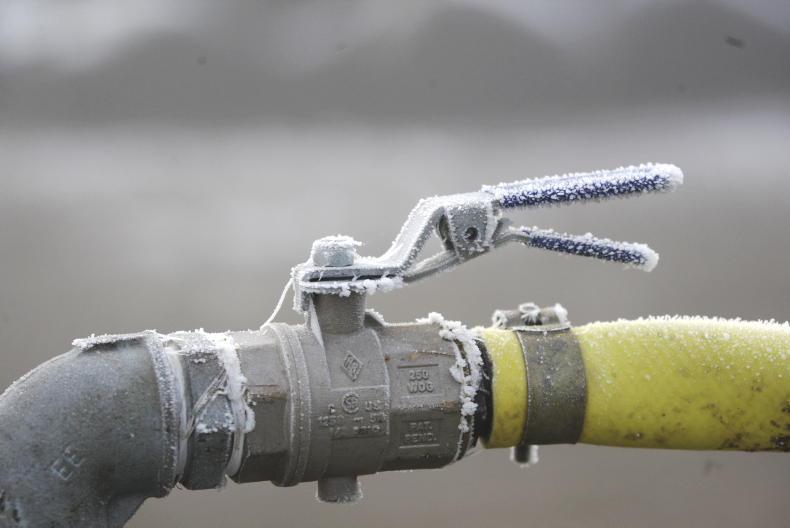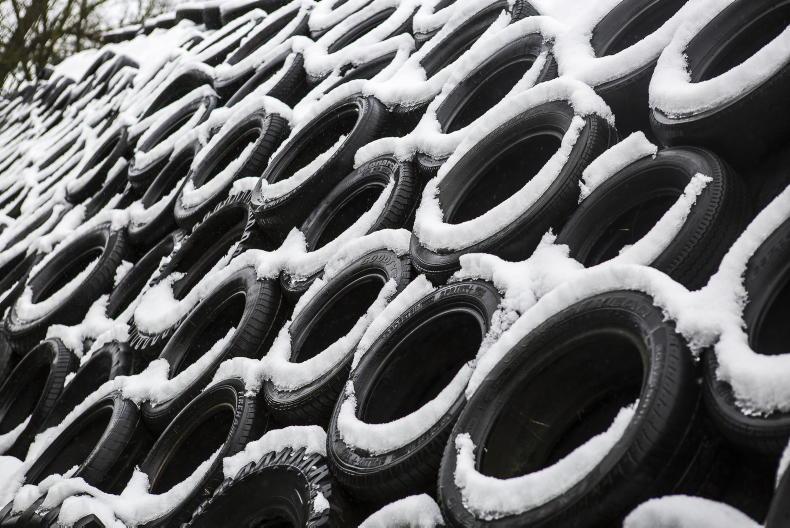It’s been a cold start to 2024 with temperatures plummeting over the last few days. Met Éireann is forecasting a further drop in temperatures over the next few days and temperatures could drop as low as -5C in some parts
of the country early next week.
Freezing temperatures make it harder for farmers to go about their daily routine and this week we take a look at some tips on how to avoid issues on your farm in the current cold snap.
1 Keeping tractors and other machinery running
Tractors are harder to start during mornings with a heavy frost. Make sure the battery on any tractor or telehandler doing the feeding routine is well charged.
Locate the jump leads, spare batteries, charger or booster pack now and store where they are easily accessible. Make sure there is a working extension lead for the booster pack and charger.

Batteries and antifreeze levels in tractors and other machinery should be checked.
If tractors have a history of being hard to start, park them so the engine and battery can be easily accessed.
Cattle sheds tend to be warmer than general storage sheds, due to the heat from animals. Parking tractors in cattle sheds can make them easier to start in the mornings. Just be mindful of getting access to the battery if a jump start is required.
Check antifreeze and top up if fluids are on the low side. When starting machines, let the engine run for a short
period to allow oil to warm up before engaging hydraulics.
Leave the greasing of moving parts until late morning or afternoon, as it will be harder to pump grease in cold conditions.

Cattle will have a higher maintenance requirement during periods of very cold weather.
2 Silage feeding
If possible, feed cattle late in the afternoon or early evening. Machines will be easier to start and ice will be less problematic.
This makes it safer to operate tractors pulling a full diet feeder between outfarms or when working in yards with a slope. Offer extra silage, if necessary, to push the feeding routine into afternoon or the evening time.
Where cattle are wintered on an outfarm, can silage bales be left in these yards before temperatures drop this week to avoid travelling on icy roads? Another good tip is to remove the silage pit cover in advance. Plastic covers on the silage pit are dangerous during frost. Removing the cover in advance during daylight hours will be a safer option.

Aim to have a back up water supply in case drinkers or pipes freeze in heavy frost.
3 Water provision
If water troughs have a tendency to freeze, can exposed pipes be lagged before temperatures drop further this week?
Fill a couple of IBC containers to have a back-up water source in case water supply is interrupted due to frost.
Again, take some steps to prepare for frozen pipes. Locate the blow torch lighter or matches to thaw water and make sure there are full gas canisters. Leaving a red light bulb switched on in a pump house can help prevent pipes around your well or pump from freezing. Cattle on high levels of meal feeding could require 50-60 litres of water/day so it’s important to factor this in if you are providing water from another source.
4 Spare parts
Heavy frost can be sore on hydraulic hoses and couplings showing a bit of wear and tear. Joints and pipes can burst or leak. The same goes with water piping and fittings for drinking troughs. Check if there are some spare parts and pipes available to make repairs if required.
5 Forage crop feeding
Feeding forage crops in the frosty weather can make management quite tricky. Frost causes higher nitrate levels in the leaves of the plant.
This can lead to poisoning of the animal if not managed correctly. Symptoms of nitrate poisoning include rapid breathing, tremors and animals down. In more severe cases, it can lead to sudden death and the first sign of a problem will be a dead animal.
The best way to avoid any potential issues is to only move stock on to their daily allocation of the crop once the frost has lifted.

Caution is required when stripping back silage pit covers as frost can leave the cover very slippy.
However, in some cases the frost has not lifted at all over the past few days and with the cold spell to continue right throughout this week and into the weekend, stock grazing these crops are at risk.
The best course of action here is to remove access to the forage crop completely or at least reduce the allocation significantly for the duration of the spell of weather. Forage crops should never make up more than two-thirds of the animal’s total diet, with the other third coming in the form of grass silage or straw. Ideally, for the rest of the week, silage should be offered to animals to substitute the forage crop proportion of the diet.
While this may not be ideal as extra baled silage will be required, it is better to be safe than sorry.
6 Outwintered animals
Outwintered animals can generally cope with cold weather very well but it’s when the cold weather is combined with heavy rain or snow showers along with wind is when issues can arise.
Make sure outwintered animals have access to a dry lie and adequate shelter during the current cold snap. Remember its not just in sheds that drinkers will freeze up. Fielddrinkers will be at a higher risk of freezing so it’s important to complete daily checks that animals have access to water. Animals will have a higher maintenance requirement during very cold weather so it’s important to remember this when providing supplementary feed.
7 Health and safety
Many part time farmers are working in the dark foddering in the mornings and also working in the dark again in the evenings in the month of January. Take care to avoid any slips or falls in the yard. Ice can appear overnight on a yard and yards can become very dangerous especially if you are rushing carrying buckets of meal around to cattle.
It’s been a cold start to 2024 with temperatures plummeting over the last few days. Met Éireann is forecasting a further drop in temperatures over the next few days and temperatures could drop as low as -5C in some parts
of the country early next week.
Freezing temperatures make it harder for farmers to go about their daily routine and this week we take a look at some tips on how to avoid issues on your farm in the current cold snap.
1 Keeping tractors and other machinery running
Tractors are harder to start during mornings with a heavy frost. Make sure the battery on any tractor or telehandler doing the feeding routine is well charged.
Locate the jump leads, spare batteries, charger or booster pack now and store where they are easily accessible. Make sure there is a working extension lead for the booster pack and charger.

Batteries and antifreeze levels in tractors and other machinery should be checked.
If tractors have a history of being hard to start, park them so the engine and battery can be easily accessed.
Cattle sheds tend to be warmer than general storage sheds, due to the heat from animals. Parking tractors in cattle sheds can make them easier to start in the mornings. Just be mindful of getting access to the battery if a jump start is required.
Check antifreeze and top up if fluids are on the low side. When starting machines, let the engine run for a short
period to allow oil to warm up before engaging hydraulics.
Leave the greasing of moving parts until late morning or afternoon, as it will be harder to pump grease in cold conditions.

Cattle will have a higher maintenance requirement during periods of very cold weather.
2 Silage feeding
If possible, feed cattle late in the afternoon or early evening. Machines will be easier to start and ice will be less problematic.
This makes it safer to operate tractors pulling a full diet feeder between outfarms or when working in yards with a slope. Offer extra silage, if necessary, to push the feeding routine into afternoon or the evening time.
Where cattle are wintered on an outfarm, can silage bales be left in these yards before temperatures drop this week to avoid travelling on icy roads? Another good tip is to remove the silage pit cover in advance. Plastic covers on the silage pit are dangerous during frost. Removing the cover in advance during daylight hours will be a safer option.

Aim to have a back up water supply in case drinkers or pipes freeze in heavy frost.
3 Water provision
If water troughs have a tendency to freeze, can exposed pipes be lagged before temperatures drop further this week?
Fill a couple of IBC containers to have a back-up water source in case water supply is interrupted due to frost.
Again, take some steps to prepare for frozen pipes. Locate the blow torch lighter or matches to thaw water and make sure there are full gas canisters. Leaving a red light bulb switched on in a pump house can help prevent pipes around your well or pump from freezing. Cattle on high levels of meal feeding could require 50-60 litres of water/day so it’s important to factor this in if you are providing water from another source.
4 Spare parts
Heavy frost can be sore on hydraulic hoses and couplings showing a bit of wear and tear. Joints and pipes can burst or leak. The same goes with water piping and fittings for drinking troughs. Check if there are some spare parts and pipes available to make repairs if required.
5 Forage crop feeding
Feeding forage crops in the frosty weather can make management quite tricky. Frost causes higher nitrate levels in the leaves of the plant.
This can lead to poisoning of the animal if not managed correctly. Symptoms of nitrate poisoning include rapid breathing, tremors and animals down. In more severe cases, it can lead to sudden death and the first sign of a problem will be a dead animal.
The best way to avoid any potential issues is to only move stock on to their daily allocation of the crop once the frost has lifted.

Caution is required when stripping back silage pit covers as frost can leave the cover very slippy.
However, in some cases the frost has not lifted at all over the past few days and with the cold spell to continue right throughout this week and into the weekend, stock grazing these crops are at risk.
The best course of action here is to remove access to the forage crop completely or at least reduce the allocation significantly for the duration of the spell of weather. Forage crops should never make up more than two-thirds of the animal’s total diet, with the other third coming in the form of grass silage or straw. Ideally, for the rest of the week, silage should be offered to animals to substitute the forage crop proportion of the diet.
While this may not be ideal as extra baled silage will be required, it is better to be safe than sorry.
6 Outwintered animals
Outwintered animals can generally cope with cold weather very well but it’s when the cold weather is combined with heavy rain or snow showers along with wind is when issues can arise.
Make sure outwintered animals have access to a dry lie and adequate shelter during the current cold snap. Remember its not just in sheds that drinkers will freeze up. Fielddrinkers will be at a higher risk of freezing so it’s important to complete daily checks that animals have access to water. Animals will have a higher maintenance requirement during very cold weather so it’s important to remember this when providing supplementary feed.
7 Health and safety
Many part time farmers are working in the dark foddering in the mornings and also working in the dark again in the evenings in the month of January. Take care to avoid any slips or falls in the yard. Ice can appear overnight on a yard and yards can become very dangerous especially if you are rushing carrying buckets of meal around to cattle.










 This is a subscriber-only article
This is a subscriber-only article










SHARING OPTIONS: